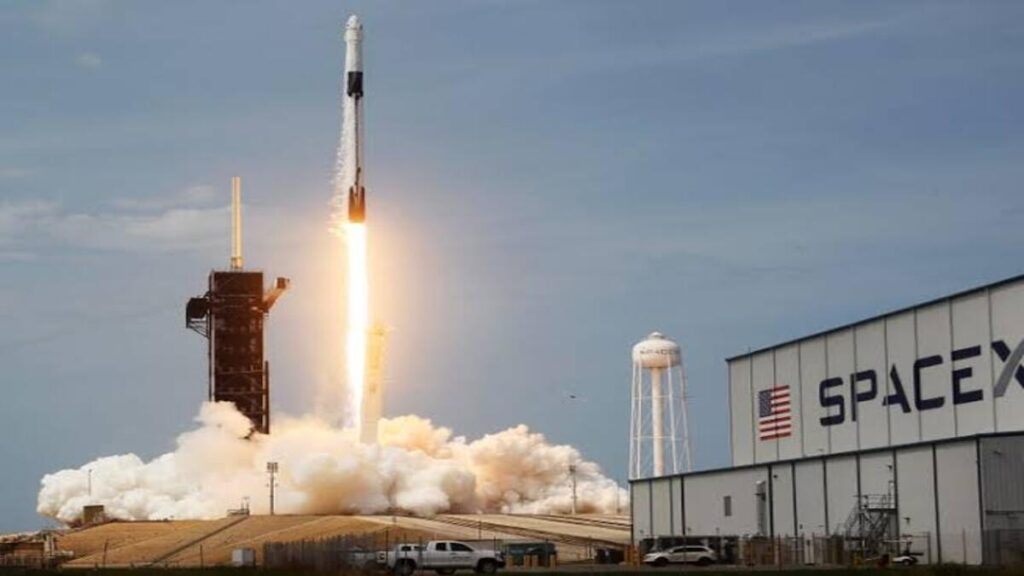
A second wave of 52 Starlink internet satellites, launched by a Falcon 9 rocket from Cape Canaveral on Saturday night, continued the expansion of SpaceX’s worldwide broadband network, which is now reachable from all seven continents.
At 7:32:10 p.m. EDT (2332:10 GMT) on Saturday, the 229-foot-tall (70-meter) Falcon 9 rocket launched from Cape Canaveral Space Force Station. As it rose into the twilight sky, the launcher shed its first stage booster and payload shroud, providing spectators with a mesmerizing vista.
The consumer-grade, high-speed, low-latency internet network of SpaceX will be expanded by the 52 Starlink satellites aboard the Falcon 9. More than 40 nations and territories now offer subscribers the ability to connect to the Starlink network.
“Starlink is now active on all continents, including Antarctica,” tweeted Elon Musk, SpaceX’s founder and CEO.
SpaceX is getting closer to deploying its initial fleet of 4,400 Starlink spacecraft with the addition of 52 additional satellites that will join the constellation on Saturday night. After the mission on Saturday night, SpaceX has orbited 3,399 Starlink satellites, including prototypes and damaged satellites. According to a calculation by Jonathan McDowell, a specialist in tracking spaceflight activity and an astronomer at the Harvard-Smithsonian Center for Astrophysics, the company currently has about 3,000 operational Starlink satellites in orbit, with about 2,500 operating and another 500 moving into their operational orbits.
Sunday night’s launch, known as Starlink 4-35, was SpaceX’s 43rd of the year.
The upper stage of the Falcon 9 rocket released the 52 Starlink satellites about 15 minutes after liftoff, sending them zipping across the North Atlantic Ocean at a speed of about 17,000 mph.
The fourth Falcon 9 mission of the month was the Starlink 4-35 mission. Before the end of September, SpaceX is aiming to launch another Falcon 9 rocket with more Starlink satellites, but that timeline is contingent on how Hurricane Ian, which is expected to make landfall in Florida next week, will affect the region.
This year, SpaceX intends to perform more than 60 flights, or roughly one launch every six days.
Shorter turnaround times between missions at launch sites in Florida and California, as well as SpaceX’s reuse of Falcon 9 rockets and payload fairings, have contributed to the greater launch rate. About two-thirds of SpaceX’s Falcon 9 flights so far this year have been satellite-carrying launches, like the one on Saturday night, for the company’s own Starlink internet network.
The reusable rocket that SpaceX used to launch the Falcon 9 on Saturday night had the serial number B1073. The rocket flew for the first time on May 14 when it launched Starlink satellites, and it did it once more on June 29 when it launched the SES 22 commercial communications satellite. The booster most recently took off and landed on a further Starlink mission on August 9.
At T-minus 35 minutes of Saturday night’s countdown, SpaceX’s launch team started putting super-chilled, densified kerosene and liquid oxygen propellants into the Falcon 9 rocket. They were positioned inside a launch control center near Cape Canaveral Space Force Station.
During the final hour of the countdown, helium pressurant also poured into the rocket. The Merlin main engines of the Falcon 9 underwent “chilldown,” or thermal conditioning for flight, in the final seven minutes before liftoff. The guidance and range safety systems aboard the Falcon 9 were also set up for takeoff.
After takeoff, the nine Merlin engines on the Falcon 9 rocket’s 1.7 million pounds of power were vectored to head northeast over the Atlantic Ocean.
After launching, the rocket ran faster than the speed of sound for nearly a minute before switching off its nine main engines. In order to help guide the booster stage back into the atmosphere after it separated from the upper stage of the Falcon 9, the booster stage fired pulses from cold gas control thrusters and extended titanium grid fins.
Nine minutes after launch, the rocket made two braking burns to slow it down for a landing on the drone ship “A Shortfall Of Gravitas” around 400 miles (650 kilometers) downrange.
During the second stage burn, the Falcon 9’s reusable payload fairing was discarded. To rescue the two nose cone parts when they splash down under parachutes, a recovery ship was also stationed in the Atlantic.
The Falcon 9 booster stage and its two parts, which fired cold gas nitrogen thrusters to regulate their orientation, were visible to viewers thanks to good visibility. The upper stage of the Falcon 9 kept gaining speed as it moved northeast, passing close to the U.S. East Coast.
Moments after the Falcon 9’s second stage engine switched off to place the Starlink satellites into orbit on Saturday’s mission, the first stage touched down. At T+plus 15 minutes, 28 seconds, SpaceX’s 52 Starlink satellites, which were made in Redmond, Washington, were confirmed to have separated from the Falcon 9 rocket.
The flat-packed satellites were freed from the upper stage of the Falcon 9 by the release of retention rods from the Starlink payload stack. In order to enter their operational orbit, the 52 spacecraft will first deploy their solar arrays and go through an automated activation process.
The satellites are launched into an elliptical orbit with a 53.2 degree inclination to the equator by the Falcon 9’s guidance computer. The remaining work necessary to place the satellites in a circular orbit 335 miles (540 kilometers) above Earth will be carried out by on-board propulsion.